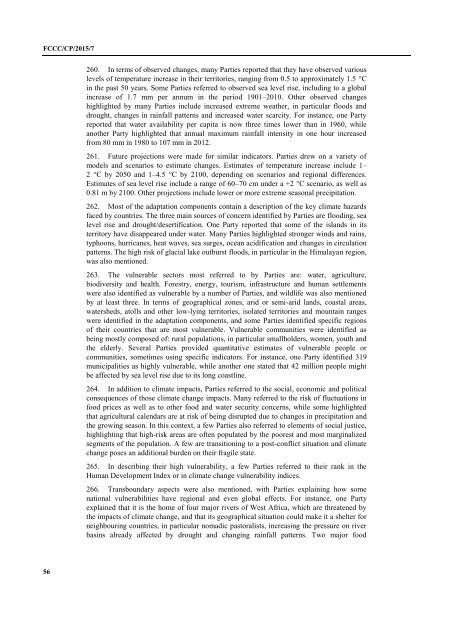FCCC/CP/2015/7
1PYuHQM
1PYuHQM
You also want an ePaper? Increase the reach of your titles
YUMPU automatically turns print PDFs into web optimized ePapers that Google loves.
<strong>FCCC</strong>/<strong>CP</strong>/<strong>2015</strong>/7<br />
260. In terms of observed changes, many Parties reported that they have observed various<br />
levels of temperature increase in their territories, ranging from 0.5 to approximately 1.5 °C<br />
in the past 50 years. Some Parties referred to observed sea level rise, including to a global<br />
increase of 1.7 mm per annum in the period 1901–2010. Other observed changes<br />
highlighted by many Parties include increased extreme weather, in particular floods and<br />
drought, changes in rainfall patterns and increased water scarcity. For instance, one Party<br />
reported that water availability per capita is now three times lower than in 1960, while<br />
another Party highlighted that annual maximum rainfall intensity in one hour increased<br />
from 80 mm in 1980 to 107 mm in 2012.<br />
261. Future projections were made for similar indicators. Parties drew on a variety of<br />
models and scenarios to estimate changes. Estimates of temperature increase include 1–<br />
2 °C by 2050 and 1–4.5 °C by 2100, depending on scenarios and regional differences.<br />
Estimates of sea level rise include a range of 60–70 cm under a +2 °C scenario, as well as<br />
0.81 m by 2100. Other projections include lower or more extreme seasonal precipitation.<br />
262. Most of the adaptation components contain a description of the key climate hazards<br />
faced by countries. The three main sources of concern identified by Parties are flooding, sea<br />
level rise and drought/desertification. One Party reported that some of the islands in its<br />
territory have disappeared under water. Many Parties highlighted stronger winds and rains,<br />
typhoons, hurricanes, heat waves, sea surges, ocean acidification and changes in circulation<br />
patterns. The high risk of glacial lake outburst floods, in particular in the Himalayan region,<br />
was also mentioned.<br />
263. The vulnerable sectors most referred to by Parties are: water, agriculture,<br />
biodiversity and health. Forestry, energy, tourism, infrastructure and human settlements<br />
were also identified as vulnerable by a number of Parties, and wildlife was also mentioned<br />
by at least three. In terms of geographical zones, arid or semi-arid lands, coastal areas,<br />
watersheds, atolls and other low-lying territories, isolated territories and mountain ranges<br />
were identified in the adaptation components, and some Parties identified specific regions<br />
of their countries that are most vulnerable. Vulnerable communities were identified as<br />
being mostly composed of: rural populations, in particular smallholders, women, youth and<br />
the elderly. Several Parties provided quantitative estimates of vulnerable people or<br />
communities, sometimes using specific indicators. For instance, one Party identified 319<br />
municipalities as highly vulnerable, while another one stated that 42 million people might<br />
be affected by sea level rise due to its long coastline.<br />
264. In addition to climate impacts, Parties referred to the social, economic and political<br />
consequences of those climate change impacts. Many referred to the risk of fluctuations in<br />
food prices as well as to other food and water security concerns, while some highlighted<br />
that agricultural calendars are at risk of being disrupted due to changes in precipitation and<br />
the growing season. In this context, a few Parties also referred to elements of social justice,<br />
highlighting that high-risk areas are often populated by the poorest and most marginalized<br />
segments of the population. A few are transitioning to a post-conflict situation and climate<br />
change poses an additional burden on their fragile state.<br />
265. In describing their high vulnerability, a few Parties referred to their rank in the<br />
Human Development Index or in climate change vulnerability indices.<br />
266. Transboundary aspects were also mentioned, with Parties explaining how some<br />
national vulnerabilities have regional and even global effects. For instance, one Party<br />
explained that it is the home of four major rivers of West Africa, which are threatened by<br />
the impacts of climate change, and that its geographical situation could make it a shelter for<br />
neighbouring countries, in particular nomadic pastoralists, increasing the pressure on river<br />
basins already affected by drought and changing rainfall patterns. Two major food<br />
56


